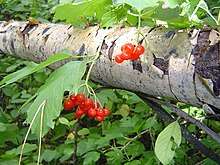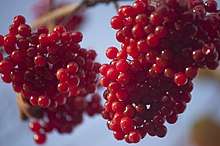Viburnum opulus
Viburnum opulus (common name: guelder-rose[1] or guelder rose; /ˈɡɛldər/[2]) is a species of flowering plant in the family Adoxaceae (formerly Caprifoliaceae) native to Europe, northern Africa and central Asia.[3]
| Viburnum opulus | |
|---|---|
| Plant with fruit | |
| Scientific classification | |
| Kingdom: | Plantae |
| Clade: | Tracheophytes |
| Clade: | Angiosperms |
| Clade: | Eudicots |
| Clade: | Asterids |
| Order: | Dipsacales |
| Family: | Adoxaceae |
| Genus: | Viburnum |
| Species: | V. opulus |
| Binomial name | |
| Viburnum opulus | |
Names
The common name 'guelder rose' relates to the Dutch province of Gelderland, where a popular cultivar, the snowball tree, supposedly originated.[4] Other common names include water elder, cramp bark, snowball tree, common snowball[5], and European cranberrybush, though this plant is not closely related to the cranberry. Some botanists also include the North American species Viburnum trilobum as V. opulus var. americanum Ait., or as V. opulus subsp. trilobum (Marshall) Clausen.
Phylogeny
The guelder rose is a member of the Viburnum genus which contains 160-170 species. It is classified in the subsection Opulus which usually contains 5 species. Phylogenetic anlyses suggest the following relationship between those species:
|
clade containing sections Sambucina, Lobata, Coriacea, and Succodontotinus | |||||||||||||||||||||||||
| Opulus sect. |
| ||||||||||||||||||||||||
Description

Viburnum opulus is a deciduous shrub growing to 4–5 m (13–16 ft) tall. The leaves are opposite, three-lobed, 5–10 cm (2–4 in) long and broad, with a rounded base and coarsely serrated margins; they are superficially similar to the leaves of some maples, most easily distinguished by their somewhat wrinkled surface with impressed leaf venation. The leaf buds are green, with valvate bud scales.
The hermaphrodite flowers are white, produced in corymbs 4–11 cm (2–4 in) in diameter at the top of the stems; each corymb comprises a ring of outer sterile flowers 1.5–2 cm in diameter with conspicuous petals, surrounding a center of small (5 mm), fertile flowers; the flowers are produced in early summer, and pollinated by insects. The fruit is a globose bright red drupe 7–10 mm diameter, containing a single seed. The seeds are dispersed by birds.
Cultivation
.jpg)

Viburnum opulus is grown as an ornamental plant for its flowers and berries, growing best on moist, moderately alkaline soils, though tolerating most soil types well. Several cultivars have been selected, including 'Roseum' (synonym 'Sterile', 'Snowball'), in which all the flowers are only of the larger sterile type, with globular flower heads. There is some confusion, as there are a few other plants, including other members of the genus Viburnum, also referred to as "snowball bush".
The shrub is also cultivated as a component of hedgerows, cover plantings, and as part of other naturalistic plantings in its native regions.
It is naturalised in North America, where it is called "European cranberrybush" (although it is not a cranberry).
The cultivars 'Notcutt’s Variety',[6] 'Roseum'[7] and 'Xanthocarpum'[8] have gained the Royal Horticultural Society's Award of Garden Merit.[9]
Uses
The fruit is edible in small quantities, with a very acidic taste; it can be used to make jelly. It is however mildly toxic, and may cause vomiting or diarrhea if eaten in large amounts.[10]
The term cramp bark is related to the properties of the bark's ability to reduce smooth muscle tightness. It is called cramp bark as relieving this type of muscle tightness is most often associated with relieving women's menstrual (period) cramps. However, this can also be used during pregnancy for cramps or pain and general muscle cramping.[11]
Cultural meaning

Mentions of the viburnum can be found throughout Ukrainian folklore such as songs, decorative art, Ukrainian embroidery, and poetry. Its symbolic roots can be traced to the Slavic paganism of millennia ago. According to a legend, kalyna was associated with the birth of the Universe, the so-called Fire Trinity: the Sun, the Moon, and the Star.[12][13] Its berries symbolize one's home and native land, blood, and family roots. Kalyna is often depicted on Ukrainian embroidery: towels and shirts. In Slavic paganism kalyna also represents the beauty of a young lady, which rhymes well in the Ukrainian language: ka-ly-na — div-chy-na.[14][15][16] The song Chervona Kalyna was the anthem of the Ukrainian Insurgent Army, and a berry cluster is today an insignia of the Ukrainian Army.
Viburnum opulus (kalina) is also one of the national symbols of Russia.[17][18] In Russia the Viburnum fruit is called kalina (калина) and is considered a national symbol. Kalina derived in Russian language from kalit' or raskalyat', which means "to make red-hot". The red fiery color of the berries represents beauty in Russian culture and together with sweet raspberries it symbolises the passionate love of a beautiful maiden, since berries were always an erotic symbol in Russia.[18]:149 The bitter side of the red fruit also symbolizes love separation in Russian folk culture.[19] The name of the Russian song Kalinka is a diminutive of Kalina. Viburnum opulus is also an important symbol of the Russian national ornamental wood painting handicraft style called Khokhloma.
References
- "BSBI List 2007". Botanical Society of Britain and Ireland. Archived from the original (xls) on 2014-10-23. Retrieved 2014-10-17.
- "guelder rose". Oxford English Dictionary second edition. Oxford University Press. 1989. Retrieved 7 December 2018.
- RHS A-Z encyclopedia of garden plants. United Kingdom: Dorling Kindersley. 2008. p. 1136. ISBN 978-1405332965.
- The Reader's Digest Field Guide to the Trees and Shrubs of Britain p.143.
- Bock, Klaus; Jensen; Nielson; Norn (1978). "Iridoid allosides from Viburnum opulus". Phytochemistry. 17 (4): 753–757. doi:10.1016/S0031-9422(00)94220-1.
- "RHS Plant Selector - Viburnum opulus 'Notcutt's Variety'". Retrieved 17 February 2019.
- "RHS Plant Selector - Viburnum opulus 'Roseum'". Retrieved 8 June 2013.
- "RHS Plant Selector - Viburnum opulus 'Xanthocarpum'". Retrieved 8 June 2013.
- "AGM Plants - Ornamental" (PDF). Royal Horticultural Society. July 2017. p. 107. Retrieved 17 February 2019.
- "Plant Database Search". www.pfaf.org.
- "Cramp Bark: Uses, Side Effects, Interactions, Dosage, and Warning". www.webmd.com.
- Lady of Prykarpattia (in Ukrainian)
- Ukrainian embroidery Archived January 13, 2010, at the Wayback Machine (in Ukrainian)
- Doctor Bozhko, Agrarian Sciences. Trees in culture by folk. (in Ukrainian)
- Doctor Kuzmenko, Philological Sciences. The symbolics of guilder rose in Ukrainian songs of the 20th century national liberating movements. (in English and Ukrainian)
- darpoj (17 July 2007). "a kalyna ne verba-live(Natalka Karpa)" – via YouTube.
- Peacebuilding with Women in Ukraine: Using Narrative to Envision a Common Future by Maureen Flaherty, Lexington Books, 2012, ISBN 0739174045 (page 172)
- Prokhorov, Vadim (2002). Russian folk songs : musical genres and history. Lanham, Md.: Scarecrow Press. ISBN 0810841274. OCLC 47208585.
- MacLaury, Robert E.; Paramei, Galina V.; Dedrick, Don (2007). Anthropology of color interdisciplinary multilevel modeling. J. Benjamins Pub. Co. pp. 418. OCLC 928983471.
External links
| Wikimedia Commons has media related to Viburnum opulus. |
| Wikispecies has information related to Viburnum opulus |
- Blamey, M. & Grey-Wilson, C. (1989). Flora of Britain and Northern Europe. Hodder & Stoughton.
- Huxley, A., ed. (1992). New RHS Dictionary of Gardening. Macmillan.
- Flora Europaea: Viburnum opulus
- Plants for a Future: Viburnum opulus
